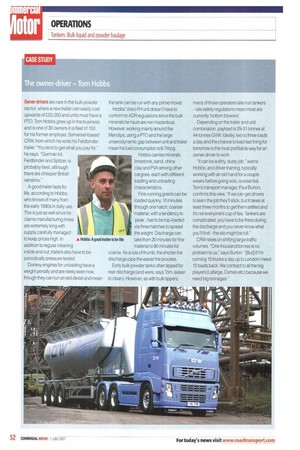The owner-driver Tom Hobbs
Page 52

If you've noticed an error in this article please click here to report it so we can fix it.
Owner-drivers are rare in the bulk powder sector, where a new trailer can easily cost upwards of £50,000 and units must have a PTO. Tom Hobbs grew up in the business and is one of 30 owners in a fleet of 150 for his former employer, Somerset-based CRW, from which he rents his Feldbinder trailer. "You tend to get what you pay for," he says. "German kit, Feld binder and Spitzer, is probably best, although there are cheaper British versions."
A good trailer lasts for life, according to Hobbs, who knows of many from the early 1990s in daily use. This is just as well since he claims manufacturing times are extremely long with supply carefully managed to keep prices high. In addition to regular cleaning inside and out, trailers also have to be periodically pressure-tested.
Donkey engines for unloading have a weight penalty and are rarely seen now, though they can run on red diesel and mean A Hobbs: A good trailer is for life the tank can be run with any prime mover.
Hobbs' Volvo FH unit doesn't have to conform to ADR regulations since the bulk minerals he hauls are non-hazardous. However, working mainly around the Mendips, using a PTO and the large unaerodynamic gap between unit and trailer mean his fuel consumption is 6-7mpg.
Hobbs carries minerals, limestone, sand, china clay and PVA among other cargoes, each with different loading and unloading characteristics.
Fine-running grains can be loaded quickly, 10 minutes through one hatch; coarser material, with a tendency to 'peak', has to be top-loaded via three hatches to spread the weight. Discharge can take from 20 minutes for fine material to 90 minutes for coarse. As a rule of thumb, the shorter the discharge pipe the easier the process.
Early bulk powder tanks often tipped for rear discharge (and were, says Torn, easier to clean). However, as with bulk tippers, many of those operators also run tankers -site safety regulations mean most are currently 'bottom blowers'.
Depending on the trailer and unit combination, payload is 29-31 tonnes at 44 tonnes GVW. Ideally, two to three loads a day and the chance to load last thing for tomorrow is the most profitable way for an owner-driver to work.
"It can be a dirty, dusty job," warns Hobbs, and driver training, typically working with an old hand for a couple weeks before going solo, is essential. Tom's transport manager, Paul Burton, confirms this view. "If we can get drivers to learn the job they'll stick, but it takes at least three months to get them settled and it's not everyone's cup of tea. Tankers are complicated, you have to be there during the discharge and you never know what you'll find-the silo might be full."
CRW relies on shifting large traffic volumes. "One thousand tonnes is no problem to us," says Burton. "[But] If I'm running 15 trucks a day up to London I need 15 loads back. We contract to all the big players (Lafarge, Cemex etc) because we need big tonnages."






















































































































































































